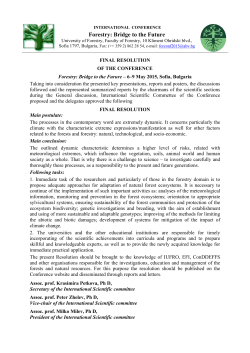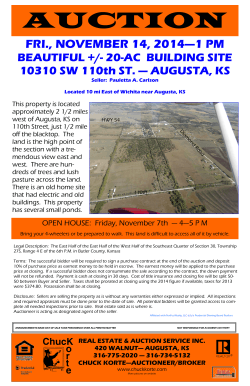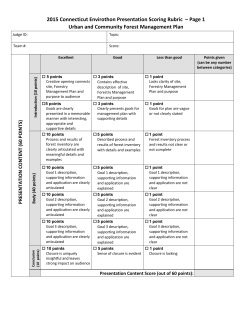
profile - Australian Natural Resources Data Library
National Indigenous Forestry Strategy Port Augusta Indigenous Coordination Centre Area profile Location • The Port Augusta ICC area is located in the north half of the State of South Australia. It comprises of approximately 67.2 million hectares, of which 5.7 million hectares are forested. • The areas boundaries are made up of the Northern Territory border to the north, New South Wales State border to the east and the Western Australia State border to the west. The area also shares common boundaries with the Ceduna and Adelaide ICC area to the south. • The area coordination office is located in the city of Port Augusta. Land Tenure • The most widespread tenure type in the area is Leasehold land, with 48% of the total area attributed to that tenure type. Other common tenure types in the area include Nature Conservation Reserves, Other Crown Land and lands with Unresolved Tenure. Port Augusta tenure types Leasehold Nature Conservation Reserve Unresolved Tenure Other Crown Land Private leasehold Total Hectares 32,314,294 12,391,664 11,132,384 10,988,429 406,681 67,233,452 Percent of total 48 18 17 16 1 100 Forest type • The most dominant forest type is Eucalypt forest, covering 5% of the total area and making up 60% of the areas forests. Acacia forests are also common, making up 33% of the areas forests. Forest Type Eucalypt Acacia Callitris Casuarina Mangroves Other Plantations Totals Total Forest (ha) Percent of forest Percent of total area 3,404,997 60 1,856,115 33 243,338 4 135,068 3 10,049 0 7,965 0 3,879 0 5,661,411 100 5 3 0 0 0 0 0 8 Soils • The centre of this area is dominated by red duplex soils, loams and calcareous earths. Regions of sandy soils are present in the northwest along with areas of non calcareous earths. Sandy soils are also present in the north east along with clays in the river and flood zones of the inland lakes. Climate • The dominant climatic zone in the area is desert hot (persistently dry) covering almost the entire region, with areas of desert warm (persistently dry) and grassland warm (persistently dry) in the south east. • On average the city of Port Augusta receives 243mm of rainfall each year, with no major dry or wet periods. • Average daily minimum and maximum temperatures in the city Port Augusta Average maximum Average minimum Mid-Winter Mid- Summer 17°C 32°C 7°C 19°C Population • Total population of ICC area: 84,855 (6% of South Australia’s population and 0.5% of the entire nation’s population). • Largest City: Whyalla (21,211) • Largest Indigenous population: Port Augusta (2,006) Social indicator table Social Indicator Total population (2001) Total population living in urban centres Total rural population Percentage of population living in urban centres Average annual growth rate based on population change (19962001) Number of people employed in forestry and logging Number of people employed in Agriculture, Fisheries and Forestry Persons employed in forestry and logging as a percentage of all persons employed in Agriculture, Fisheries and Forestry Proportion of employed persons working in the industry sector of forestry and logging Number of people employed in Paper and Wood Products Manufacturing Proportion of employed persons working in the industry sector of Wood and Paper product manufacturing Percentage of high income households Proportion of low income households In ICC Area 84,855 67,645 17,210 79.7% State or Territory National 1,458,327 18,757,139 1,300,539 16,823,254 157,788 1,933,885 89.2% 89.7% -0.6% 26 0.5% 862 1.1% 10,944 3,218 36,855 330,466 0.8% 2.3% 3.3% 0.08% 0.14% 0.13% 90 6,163 63,383 0.28% 18.6% 20.4% 0.98% 23.2% 16.4% 0.78% 29.4% 13.9% ICC Areas: Regional socio-demographic figures were compiled from aggregated 2001 SLA data. The population of an SLA was attributed to an ICC area if over 50% of the SLA fell within that area. Climate information data source: Australian Bureau of Meteorology, (BOM) 2006, ‘Climate Averages for Australian Sites’. Social Indicator data source: Australian Bureau of Statistics (ABS) 1996-2001, Census of Population and Housing. Data based on the place of enumeration. Data supplied by ABS as customised tables at statistical local area (SLA) geography. Disclaimer: Data used are assumed to be correct as received from the data suppliers. The Bureau of Rural Sciences, its employees and advisors disclaim any liability, including all liability for negligence, any loss, damage or injury incurred by any person as a result of accessing, using or relying upon any of the information or data set out in this publication to the maximum extent permitted by law.
© Copyright 2025













